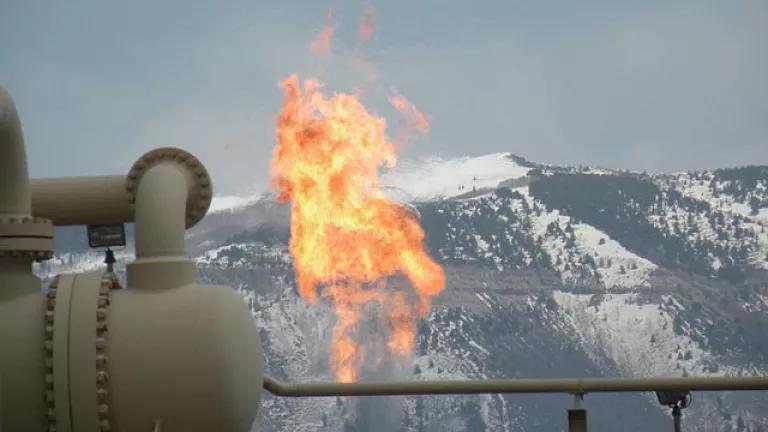Cut Methane to Help Beat the Near-Term Heat
We have to walk and chew gum—control methane and carbon dioxide—at the same time.
Curbing methane—the second most important climate pollutant—now sits at the top of the world’s to-do list if we hope to head off the worst impacts of our rapidly and dangerously changing climate, according to two major international science reports released this summer.
For decades, most attention has focused on carbon dioxide, primarily from burning fossil fuels. And over the long haul, that is exactly right, for emissions of CO2 are much greater than any other climate-changing pollutant and they last in the atmosphere for well over a century, soaking up the sun’s heat every year. So we must amp up the transition to clean energy and net-zero CO2 emissions—indeed to net-negative emissions—without any more delay.
But there’s an equal need to amp up controls on methane. That is a top-line message of this month’s report by the Intergovernmental Panel on Climate Change, and of the Global Methane Assessment released in June by the UN Environment Programme and the Climate and Clean Air Coalition.
The IPCC report concluded that methane is the second biggest factor in the warming we’ve experienced to date – more than a degree Centigrade (nearly two degrees Fahrenheit) since the 19th century. Methane has caused about two-thirds as much of our current warming as CO2 (Summary for Policy Makers, Fig. SPM.2). Looking to the future, the IPCC says: “Sustained methane mitigation, wherever it occurs, stands out as an option that combines near and long term gains on surface temperature (high confidence) and leads to air pollution benefit by reducing globally the surface ozone level (high confidence).” (Chapter 6, Short-Lived Climate Forcers, pp. 6-74)
The Global Methane Assessment is even more specific:
Available targeted methane measures, together with additional measures that contribute to priority development goals, can simultaneously reduce [global] human-caused methane emissions by as much as 45 per cent, or 180 million tonnes a year (Mt/yr) by 2030. This will avoid nearly 0.3°C of global warming by the 2040s and complement all long-term climate change mitigation efforts. It would also, each year, prevent 255,000 premature deaths, 775,000 asthma-related hospital visits, 73 billion hours of lost labour from extreme heat, and 26 million tonnes of crop losses globally.
Methane’s importance comes from four factors—three scientific and one economic. First, when it’s in the air a molecule of methane—CH4—soaks up much more solar radiation than a molecule of CO2. Second, methane has a much shorter lifetime in the air than CO2. It’s mostly gone 12 years after its release.
Those two factors combine to mean that, third, methane soaks up more than 80 times as much solar radiation as CO2, pound for pound, over the first two decades after its release. And that means that preventing each ton of methane emissions over the next couple of decades will deliver far more near-term temperature reduction than a ton of CO2 reductions.
And fourth, deep reductions in methane emissions are already available at low cost—often no cost at all—by adopting already available technological and management practices in three key sectors: gas, oil, and coal production; management of human garbage; and production of livestock, rice, and other agricultural commodities.
The nearest term opportunities are domestic and international steps to stop methane leakage in gas, oil, and coal production.
- President Biden’s day-one executive order directed the Environmental Protection Agency to propose new regulations by this September to cut methane leakage and flaring from gas and oil operations—the country’s single largest industrial source of methane (and the third largest climate polluter in the U.S., trailing only CO2 from vehicles and power plants). There’ve been huge advances in detecting methane (with infrared cameras and satellites) and zipping up leaky systems. So with the right EPA regulations, industry can cut those emissions from both new and existing operations by at least 65 percent by 2025.
- The president’s Build Back Better plan, and the budget reconciliation bill now before Congress, include funding to cap off thousands of leaking but abandoned oil and gas wells. The Senate’s budget resolution also includes a hefty fee on oil and gas methane emissions. Similar measures are needed to stop methane leakage from both active and abandoned coal mines.
- At the November meeting of the parties to the Paris Climate Agreement in Glasgow, all countries need to up their game on methane leakage from oil, gas, and coal operations. It’s critical that the parties adopt concrete steps—both producer nations, and consumer nations, which can set conditions on the life-cycle emissions of the gas they will buy.
EPA has already set rules to limit emissions from landfills, where garbage degrades into methane, and more can be done here and abroad by better managing wastes and by capturing and using gas that otherwise would escape to the air.
And there are many practical measures to prevent methane releases from livestock operations, rice farming, and other agricultural processes.
For a long time, in both U.S. and international climate policy-making, it could be said that CO2 sucked all the oxygen from the room. But that’s now changing, as scientists, advocates, and government officials recognize the need to curb multiple pollutants—CO2, methane, and other potent short-lived climate pollutants like HFCs—at the same time.
We need to do both—cut the powerful short-lived pollutants for immediate benefit, and cut carbon dioxide for long-term survival—to have a chance to keep warming below 1.5 degrees C or even 2 degrees C (2.7 to 3.6 degrees F) and help our children and grandchildren avoid far more catastrophic harms than we are already experiencing today.





